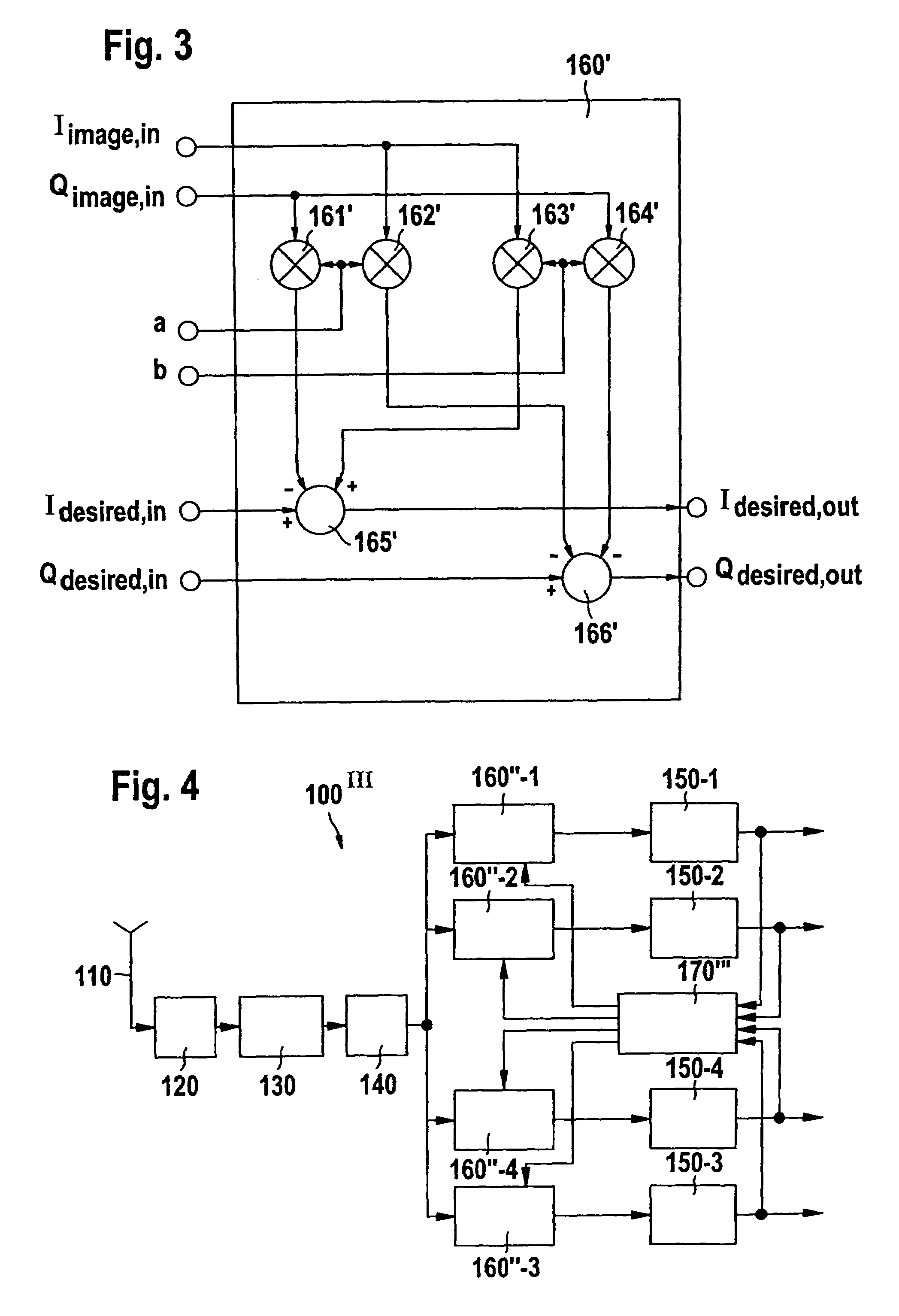Direct conversion receiver
- Summary
- Abstract
- Description
- Claims
- Application Information
AI Technical Summary
Benefits of technology
Problems solved by technology
Method used
Image
Examples
first embodiment
[0023]FIG. 1 shows the direct conversion receiver DCR 100′ according to the invention.
[0024]Said DCR 100′ serves for receiving a multi-carrier signal including at least a first and a second carrier signal—see spot S1—being located at image carrier frequencies via an antenna 110. After passing a front end 120 that can include itself some frequency band transposition the multi-carrier signal is directly down-converted to base band by a quadrature demodulator 130. The limited image rejection capabilities of said traditional quadrature demodulator 130 cause a superposition of the desired carrier signals and their images as described above by referring to FIG. 7. This effect is further illustrated for a multi-carrier signal comprising four carrier signals C1, C2, C3 and C4 by the spots S1 and S2 shown in FIG. 1. The images caused by the carrier signals C1 . . . C4 are assigned by the reference numerals I1 . . . I4, respectively.
[0025]After being output by the quadrature demodulator 130 t...
second embodiment
[0037]FIG. 3 shows a preferred embodiment of the indirect compensator stages 160′-1 . . . 160′-4 as used in the first and second embodiment of the DCR in FIGS. 1 and 2, respectively.
[0038]From FIG. 3 it is apparent that each of the compensator stages receives the real component Idesired, in of the translated carrier signal to be cleaned. Further, the imaginary component Qdesired, in of the translated carrier signal to be cleaned is received. For calculating the cleaned components Idesired, out and Qdesired, out the compensator stages 160′ further receive the real component Iimage, in of that translated carrier signal, an image of which is included in the translated carrier signal which is desired to be cleaned. Further, the indirect compensator stage 160′ receives the imaginary component Qimage, in of the translated carrier signal an image of which is included in the translated carrier signal desired to be cleaned at the port. Finally, the indirect compensator stage 160 receives the...
third embodiment
[0050]FIG. 4 shows the direct conversion receiver according to the invention. The operation of the antenna 110, the front end 120, the quadrature demodulator 130, the A / D-converter 140 and of the direct down-converters 150-1 . . . 150-4 and the operations of these components are the same as described above.
[0051]However, the third embodiment of the direct conversion receiver differs from the second embodiment substantially in that the compensator stages 160″-1 . . . 160″-4 are now connected in series between the A / D-converter 140 and the digital down-converters 150-1. Thus, the digitized multi-carrier signal output by said A / D-converter 140 is now received by said compensator stages 160″-1 . . . 160″-4 and these compensator stages output a cleaned multi-carrier signal; i.e. the output multi-carrier signal is substantially free of undesired image signals. The cleaned multi-carrier signals output by the compensator stages 160″-1 . . . 160″-4 are received by the individually co-ordinat...
PUM
 Login to View More
Login to View More Abstract
Description
Claims
Application Information
 Login to View More
Login to View More - R&D
- Intellectual Property
- Life Sciences
- Materials
- Tech Scout
- Unparalleled Data Quality
- Higher Quality Content
- 60% Fewer Hallucinations
Browse by: Latest US Patents, China's latest patents, Technical Efficacy Thesaurus, Application Domain, Technology Topic, Popular Technical Reports.
© 2025 PatSnap. All rights reserved.Legal|Privacy policy|Modern Slavery Act Transparency Statement|Sitemap|About US| Contact US: help@patsnap.com



